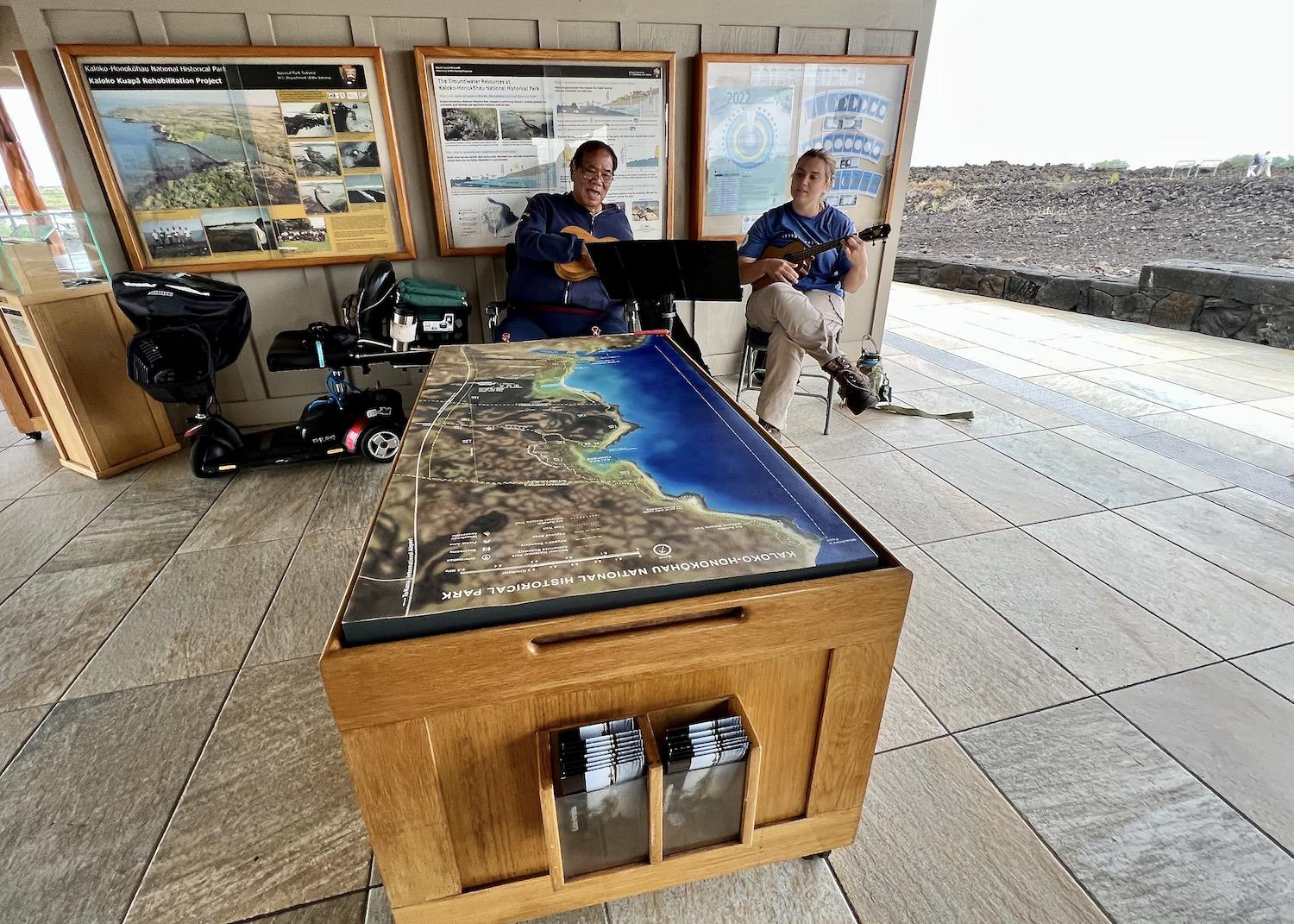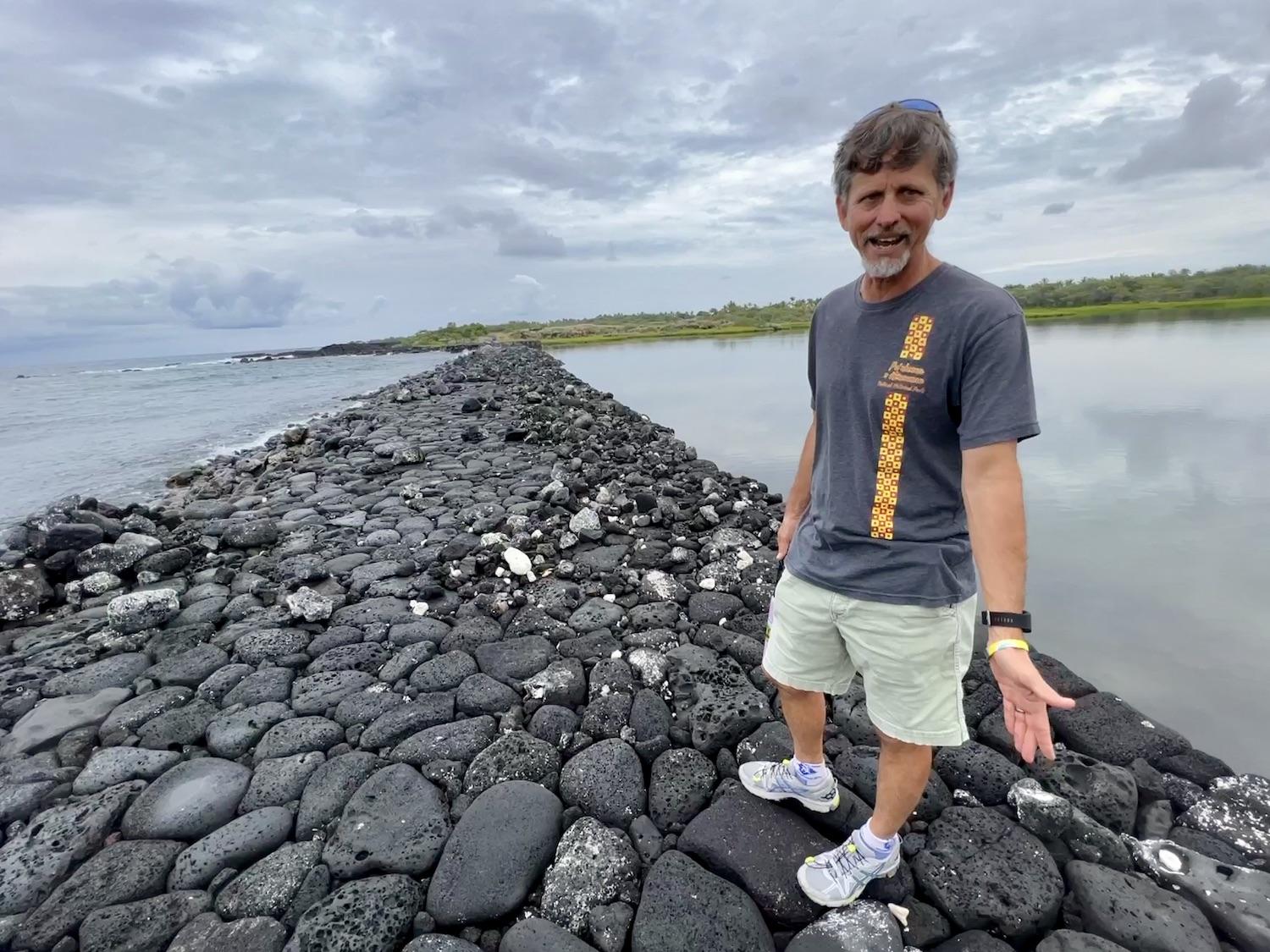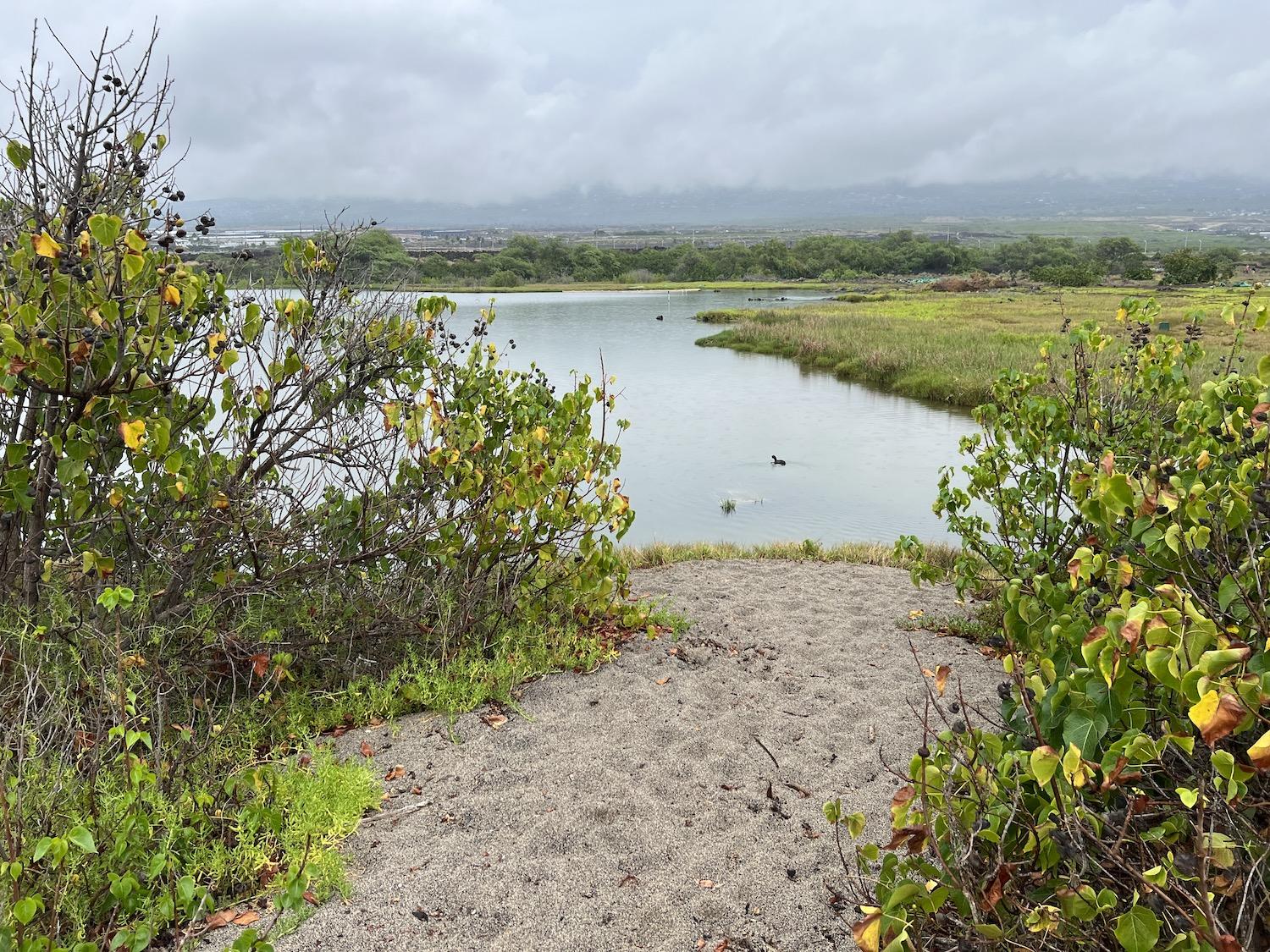
Visitors to Kaloko-Honokōhau National Historical Park usually head out in search of green sea turtles/Jennifer Bain
Twelve hours into my first trip to Hawaiʻi Island, I’m confronted with an unexpected quandary at Kaloko-Honokōhau National Historical Park. Is my sunscreen reef-safe or harmful to coral reefs and marine life like the threatened green sea turtles that gravitate to these shores?
The issue is laid out on a table at the open-air visitor contact station. There’s a coral health time machine, a guide to sunscreen chemicals and marine life, and a reef-friendly sun protection guide. There’s also a bin of undesirable chemical sunscreens that visitors have swapped for the mineral-based stuff.
What I don’t want on my sunscreen ingredient list — oxybenzone, octocrylene, avobenzone, benzophenone-1, benzophenone-8, OD-PABA, 4-Methylbenzylindene camphor, 3-Benzylidene camphor, homosalate, octinoxate, octisalate and nanoparticles. What I do want — zinc oxide and titanium dioxide.
My travel-size tube, unfortunately, is full of octocrylene, avobenzone and homosalate.

Ranger Emily Bankston shows a sample of reef-safe mineral sunscreen at Kaloko-Honokōhau National Historical Park/Jennifer Bain
“So that is what they would say is protecting you from the sun,” ranger Emily Bankston explains. “It’s also the ingredients that are harming the marine life. It’s not just the fish and their infertility increase. The dolphins get these lumps and tissue deformations. The mussels are kind of defecting young. It’s the kelp forests, too — and kind of all marine life.”
The intention, she continues, is to educate visitors, “especially because the park is so close to the coast. You walk down and you’re right in the water. So, if we see people spraying right in the parking lot and they walk right up and they go right to the turtles and spread it in the water — it’s a direct relationship, right?”
I toss my chemical sunscreen in the bin, and Bankston hands me a sample of Little Hands Hawaii reef-safe, biodegradable mineral sunscreen. The only active ingredient is non-nano zinc oxide.

The sunscreen exchange display at Kaloko-Honokōhau National Historical Park's visitor contact center/Jennifer Bain
In 2021, Hawaiʻi became the first U.S. state to ban the sale or distribution of sunscreen containing the coral-harming chemicals oxybenzone and octinoxate (unless you have a licensed prescription). For further emphasis, Hawaii County passed a law banning the sale and distribution of non-mineral sunscreens on Hawaiʻi Island as of Dec. 1, 2022.
The National Park Service estimates that 4,000 to 6,000 tons of sunscreen wash off swimmers into oceans worldwide each year, and that 10 percent of coral reefs are threatened by sunscreen-induced bleaching. Even when we rinse in the shower, sunscreen winds up in groundwater or freshwater streams that lead to the ocean. Sunscreen exchange programs run here at Kaloko-Honokōhau as well as nearby Puʻuhonua o Hōnaunau National Historical Park and Puʻukohola Heiau National Historic Site.
Once my sunscreen situation is rectified, I am ready to get to know Kaloko-Honokōhau.

Kaloko-Honokōhau National Historical Park is just minutes from Kailua-Kona and its international airport/Jennifer Bain
Established in 1978 to preserve, protect and interpret traditional native Hawaiian activities and culture, this 1,160-acre park is on the west coast of Hawai‘i Island. It’s about three miles south of Ellison Onizuka Kona International Airport at Keāhole and three miles north of Kailua-Kona, where I spend my first two island nights at Courtyard King Kamehameha’s Kona Beach Hotel. That’s why Kaloko-Honokōhau, just eight minutes away, becomes my first stop.
As volunteer Rance Pinao strums his ‘ukulele in the visitor station, I read that this park land was an ancient Hawaiian settlement and encompasses the coastal portions of five ahupua‘a — traditional sea to mountain land divisions.
Kaloko-Honokōhau is the only National Park System unit with three types of Loko i‘a that were used for food production. There are two fishponds (a loko kuapā and a loko pu‘uone) and a loko ‘Ume Iki (fishtrap). There are kahua (house site platforms), petroglyphs, ancient trails, heiau (a religious temple), lava fields and anchialine pools where red shrimp linger in water pools in the lava’s crevices and cracks. The Ala Kahakai National Historic Trail runs through the park and beyond. The 175-mile "trail by the sea" encompasses a network of culturally and historically significant trails and traverses wahi pana (storied landscapes), ancient Hawaiian sites and more than 200 ahupuaʻa.
But despite all of these cultural and historical riches, the top question among the 260,000-odd annual visitors here is always “where can we see the sea turtles?”

Volunteer Rance Pinao, left, plays ukulele in the visitor contact station/Jennifer Bain
Green sea turtles — known locally as honu — have lived on this planet for 150 million years since the Jurassic period. They used to be hunted for their meat, fat and eggs, but got federal protection as a threatened species in 1978, the same year that Kaloko-Honokōhau came into the NPS fold.
More than 136 turtles regularly use the park and are likely long-term residents. They’re all juvenile or sub-adults weighing 19 to 138 pounds instead of adults weighing 200 to 400 pounds. They bask on the rocks or sand, swim offshore and feed on seaweed in the shallow waters that were modified long ago by Hawaiians to raise fish. The NPS studies them with the Marine Turtle Research Program of the National Marine Fisheries Service. Marine biologists tag and monitor them and perform health checkups. When they become adults, they move to the French Frigate Shoals to lay their eggs. They live 80 or 90 years.
The first turtle I spot is a giant one outside the visitor center, its brilliant green shell contrasting nicely with the lava field. But it’s actually just a statue that’s slated to be relocated somewhere less prominent.

On Honokōhau Beach, park visitors watch for marine life by a sign about keeping 20 feet from green sea turtles/Jennifer Bain
To see live turtles, I join ranger Jon Jokiel at Honokōhau Beach. Signs warn people to stay at least 20 feet away from these protected creatures, but of course everyone wants photos and many get too close and disturb them.
“People just go crazy — seeing a green sea turtle is a highlight of their trip,” Jokiel says. “They’re like cattle — they just graze all day, eat and sleep. They’ll come up on the beach and then they’ll swim over here and eat things like algae, whatever’s on the rocks. They’re pretty docile. They’re pretty used to people. When they’re on the beach they couldn’t care less, so they might raise an eyeball and look at you. They’re pretty approachable, and I guess they’re cute.”
As we watch a few swimmers, Jokiel says coral reefs are already stressed and so education about chemical sunscreen is ongoing. “It’s also not good for your skin — it’s something that you absorb. Most people don’t know about it and they actually get very angry, asking `why is that allowed to be sold in the stores?’ But luckily, it looks like that’s changing. To wear a long-sleeve shirt or a hat, that’s probably the best thing. But if you have to put on sunscreen, put on a sunblock. Better for your health, better for the reef’s health.”

It's admittedly less exciting to see green sea turtles feeding in the water than sunning themselves on land/Jennifer Bain
We’re standing in the algae-rich tide pool area on the lava bench where turtles hang out between ‘Aimakapā Fishpond and ‘Ai‘ōpio Fishtrap. Sure enough, we easily spot two turtles quietly feeding in the shallows and occasionally poking their heads above water. One even sports an old tag — HA146. Now digital chips are put in their flippers for easy scanning.
It’s lovely to see what we can of these prehistoric creatures, but I get that it must be much more exciting to properly see them on land.
Jokiel also wants to make sure that I see the fishponds and fishtrap that Hawaiians built to raise and capture fish.

Ranger Jon Jokiel stands on the ancient stone wall at the Kaloko Fishpond/Jennifer Bain
The Kaloko Fishpond at the north end of the park features a stone wall that’s 800 feet long and up to 40 feet wide in places. Masons dry stack stones without using mortar to enclose the mouth of a small bay. These walls have been cleverly angled to diffuse the energy of ocean waves while allowing new sea water to penetrate through porous lava rocks and circulate about the pond. A large sluice gate allows for further water exchange and prevents larger fish from escaping.
“This is a royal fish pond so only the elites were allowed here,” says Jokiel. The wall is in a constant state of repair due to storms, but he's able to unlock a security gate and take me for a walk along it. Mullet and milkfish are two types of fish that currently live here. Invasive species like pickleweed (glassworts), kiawe (a species of mesquite) and paspalum grass are being removed at the back of the pond.

The ‘Aimakapā Fishpond is a wetland that draws native and migratory birds/Jennifer Bain
Near the center of the park, the ‘Aimakapā Fishpond was once used to raise fish for chiefs. Now this wetland, with a channel that connects the pond to the ocean, is a popular birding area that is home to endangered Hawaiian stilt and Hawaiian coot.
Finally, back at the park’s south end by Honokōhau Beach, I see the remains of the ‘Ai‘ōpio Fishtrap. This 1.7-acre pond made of a stone and coral wall forms an artificial enclosure along a curved shoreline. Fish were trapped here but not raised. They entered at high tide through an opening to the sea. At low tide, they became trapped and easily netted.
As peaceful as it may seem when you're standing by the fishponds and fishtrap, this park actually faces encroachment challenges on all sides. Neighbors include a small boat harbor, golf course, private club community and industrial park. At the main park entrance, you turn left off Queen Ka'ahumanu Highway at the Costco and you can spot the retail behemoth from several trails.

Kaloko-Honokōhau features a looped boardwalk called Ki‘i Pōhaku (Petroglyph Path) and this Papamū (a checkerboard of small holes used for a board game called Kōnane)/Jennifer Bain
Talk turns to the pandemic, overtourism challenges and how there’s a desire to draw more people to Hawai‘i who are interested in cultural tourism.
“A place like a national park is perfect for that — where we can talk about the Hawaiian culture being a living culture, the people that lived here and tell the stories. We have demonstrations. We have ‘ukulele — you saw Rance up there,” says Jokiel. “I would personally love to have more of the tourist who is very interested in the culture and the traditions. I do have those and it’s very refreshing because I would say by and large, people just want to see the beach and you want to talk to them about more.”

Park visitors photograph green sea turtles feeding in the shallows by Honokōhau Beach/Jennifer Bain
After the ranger and I part ways, I can’t resist one more peek at Honokōhau Beach in search of a few more green sea turtles and maybe even endangered Hawaiian monk seals.
I walk down the Ala Mauka Makai trail from the visitor center, taking a short side trip along a looped boardwalk to see petroglyphs. Interpretation of these fragile images pecked into rock is precarious, I read, and exact meanings may never be known despite insight from elders, researchers and oral histoy. Still, there are seven stops and I marvel at female images, western muskets, a crouching form and Papamū (a checkerboard of small holes used for a board game called Kōnane).
Petroglyphs across the state have been lost to erosion, lava flows, development and even battering by horses, goats and pigs. "Will this site still be here in 100 years? 500 years?" asks a booklet tucked into a wooden box at the start of the boardwalk. "How would you feel if this field was vandalized or lost? What responsibility do we have to help protect this resource for future generations?"
There is much to consider as I make my way to the beach. Turtles are still blithely feeding in various tidal pools. The sky is dark and a downpour is looming, so it's no surprise that the turtles aren't sunning themselves on the beach. People are milling about on the rocks, taking photos and — for now — behaving.

 Support Essential Coverage of Essential Places
Support Essential Coverage of Essential Places



